4WD FORD EXPEDITION 1997 1.G Owners Manual
[x] Cancel search | Manufacturer: FORD, Model Year: 1997, Model line: EXPEDITION, Model: FORD EXPEDITION 1997 1.GPages: 224, PDF Size: 2.2 MB
Page 3 of 224

Drivingchapter as well as the
special ªFour Wheelingº
supplement included with AWD
and 4WD vehicles.
BREAKING-IN YOUR VEHICLE
There are no particular breaking-in
rules for your vehicle. Simply avoid
driving too briskly during the first
1,600 km (1,000 miles) of driving.
Vary speeds frequently. This is
necessary to give the moving parts
a chance to break in.
If possible, you should avoid full
use of the brakes for the first
1,600 km (1,000 miles).
From 1,600 km (1,000 miles)
onwards you can gradually
increase the performance of your
vehicle up to the permitted
maximum speeds.
INFORMATION ABOUT THIS
GUIDE
The information found in this
guide was in effect at the time of
printing. Ford may change the
contents without notice and
without incurring obligation.
SPECIAL NOTICES
Using your vehicle as an
ambulance
Do not use this vehicle as
an ambulance.
com_breaking_vehicle.01
com_info_guide.01
exd_special_notices_title
exd_special_ambulance
exd_special_plow
Introduction
3
Page 6 of 224
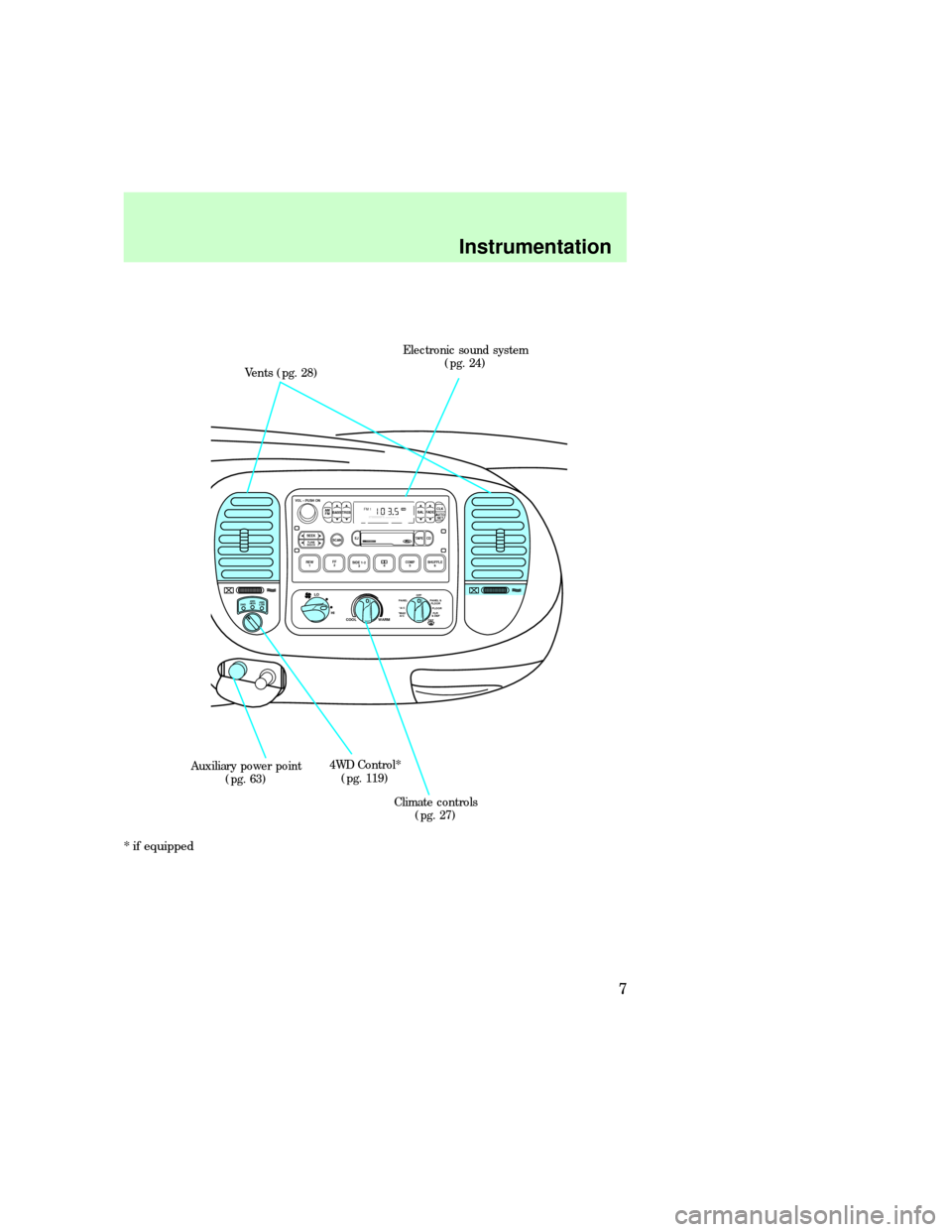
* if equipped
REW
1FF
2SIDE 1-2
3
FM 1STVOL – PUSH ON
AM
FMBASS TREBBAL FADE
AUTO
SET CLK
SEEKTUNE
DISCSSCAN
4
DOLBY SYSTEMEJTAPE CD
COMP5SHUFFLE
6
WARM COOLFLR
& DEF *MAX
A/CFLOOR PANEL &
FLOOR
DEF OFF
PANEL
*A/C
LO
HI2WD4WD
HIGH4WD
LOW
Vents (pg. 28)Electronic sound system
(pg. 24)
Climate controls
(pg. 27) 4WD Control*
(pg. 119) Auxiliary power point
(pg. 63)
Instrumentation
7
Page 10 of 224
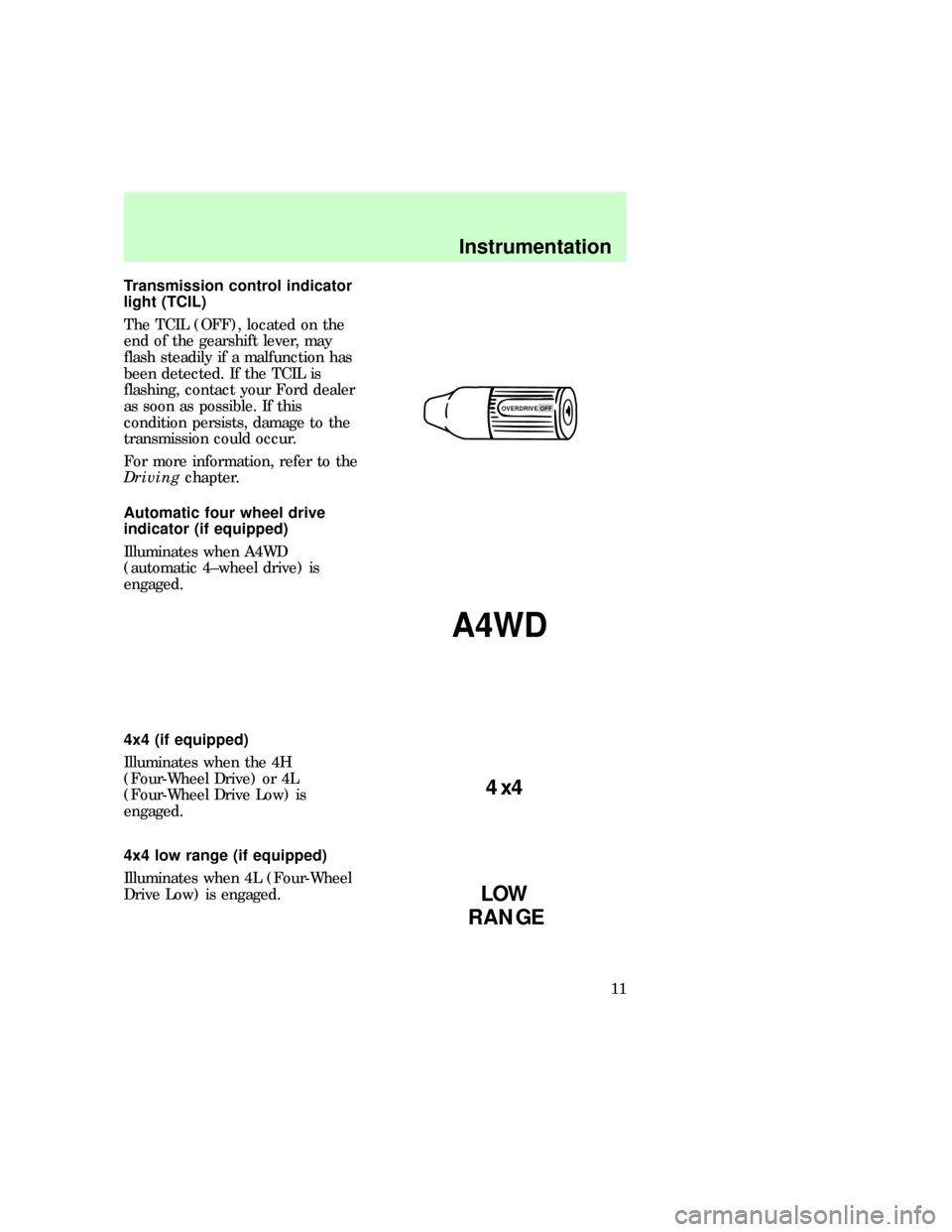
Transmission control indicator
light (TCIL)
The TCIL (OFF), located on the
end of the gearshift lever, may
flash steadily if a malfunction has
been detected. If the TCIL is
flashing, contact your Ford dealer
as soon as possible. If this
condition persists, damage to the
transmission could occur.
For more information, refer to the
Drivingchapter.
Automatic four wheel drive
indicator (if equipped)
Illuminates when A4WD
(automatic 4±wheel drive) is
engaged.
4x4 (if equipped)
Illuminates when the 4H
(Four-Wheel Drive) or 4L
(Four-Wheel Drive Low) is
engaged.
4x4 low range (if equipped)
Illuminates when 4L (Four-Wheel
Drive Low) is engaged.
OVERDRIVE OFF
A4WD
4x4
LOW
RANGE
exd_a4wd_light exd_4x4_high
exd_low_range
com_anti-lock_brake.01
Instrumentation
11
Page 21 of 224
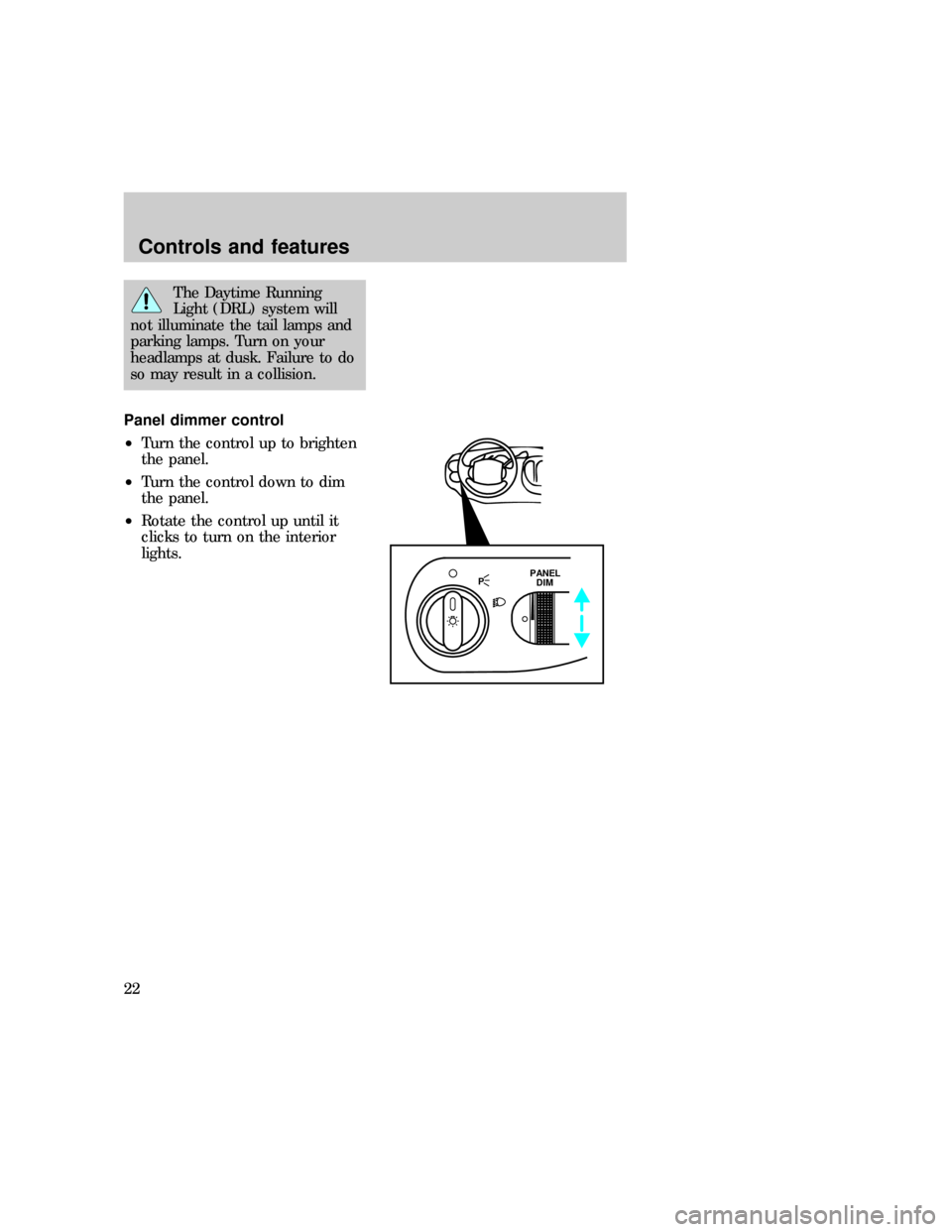
The Daytime Running
Light (DRL) system will
not illuminate the tail lamps and
parking lamps. Turn on your
headlamps at dusk. Failure to do
so may result in a collision.
Panel dimmer control
²Turn the control up to brighten
the panel.
²Turn the control down to dim
the panel.
²Rotate the control up until it
clicks to turn on the interior
lights.
PPANEL
DIM
exd_ip_dimmer_operation
exd_4wd_control
Controls and features
22
Page 22 of 224

4WD control (if equipped)
This control operates the Control
Trac 4WD. Refer toControl trac
systemin theDrivingchapter for
more information.
Auxiliary power point
This 12V power point is an
additional power source for
electrical accessories.
Do not plug optional electrical
accessories into the cigarette
lighter. Use the power point.
PHI LO
2H4LA4WD4HOFF*A/C*MAX
A/CREW
1FF
2SIDE 1-2
3
FM 1STVOL – PUSH ON
AM
FMBASS TREBBAL FADE
AUTO
SET CLKSEEKTUNE
DISCSSCAN4DOLBY SYSTEMEJTAPE CDCOMP5SHUFFLE
6
2H 4LA4WD4H
exd_power_point
exd_audio_location
Controls and features
23
Page 111 of 224

and selection of two or four-wheel
drive modes.
The air suspension system places
the vehicle at its lowest height to
provide easy entry and exit when
the vehicle is parked, the ignition
is turned off and all doors are
closed.
The air suspension system raises
the vehicle approximately 2.5 cm
(1 in) to its normal ride position
when the ignition is turned on, the
transmission is initially shifted into
the drive or reverse mode and all
doors are closed.
In 4WD Low, the air suspension
system raises the vehicle an
additional 2.5 cm (1 in) above the
normal ride height to improve
vehicle ground clearance. However,
if the vehicle speed exceeds 40
km/h (25 mph), the system will
lower the vehicle to its normal ride
height to maximize ride comfort.
The vehicle will raise again if
vehicle speed is less than 13 km/h
(8 mph) for one minute. In 4WD
Low, do not exceed 56 km/h (35
mph).
As a safety consideration,
whenever a door is opened
(including the liftgate and liftgate
glass) the system memorizes and
maintains the height at the
moment the door was opened. The
system will maintain this height
until all doors are closed or until
vehicle speed exceeds 16 km/h (10
mph).
Driving
112
Page 117 of 224
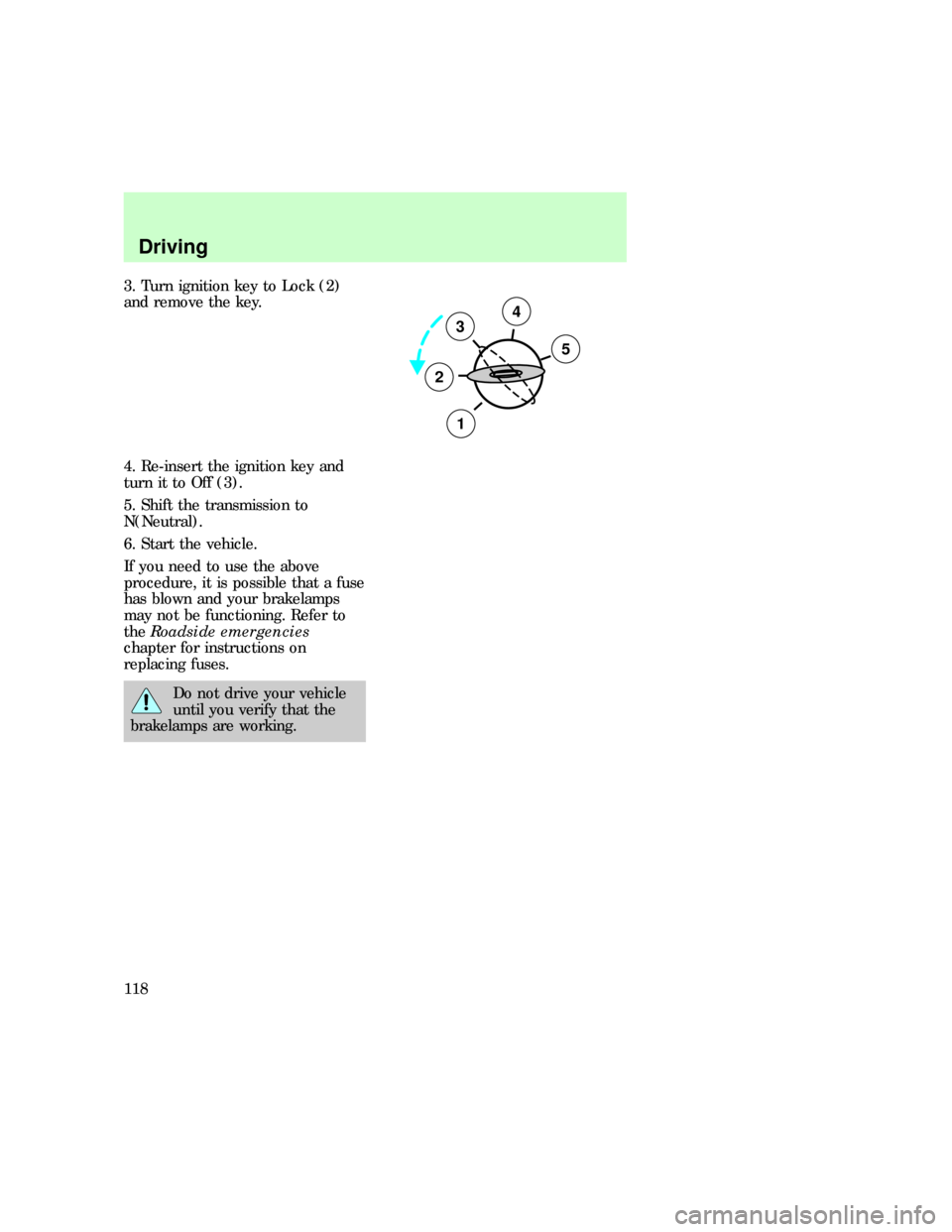
3. Turn ignition key to Lock (2)
and remove the key.
4. Re-insert the ignition key and
turn it to Off (3).
5. Shift the transmission to
N(Neutral).
6. Start the vehicle.
If you need to use the above
procedure, it is possible that a fuse
has blown and your brakelamps
may not be functioning. Refer to
theRoadside emergencies
chapter for instructions on
replacing fuses.
Do not drive your vehicle
until you verify that the
brakelamps are working.
3
2
1
5
4
exd_4wd_operation
Driving
118
Page 118 of 224

CONTROL TRAC-AUTOMATIC
FOUR-WHEEL DRIVE SYSTEM
(IF EQUIPPED)
Your 4x4 features a heavy-duty
Control Trac system, includes a
computer-operated transfer case.
Coupled with a
center-disconnected front axle, this
unique system is interactive with
the road, continually monitoring
and adjusting torque delivery to
the front and rear wheels to
optimize vehicle control.
Positions of the Control Trac
system
The Control Trac A4WD system
functions in four modes:
²2Hposition delivers power only
to the rear axle.
²A4WDposition delivers power
to the rear axle, and the front
axle when road conditions
dictate the need for increased
traction.
²4Hposition provides
mechanically locked four-wheel
drive power delivery to front
and rear axles.
²4Lposition provides
mechanically locked four-wheel
drive when above average power
at reduced speeds is required.
PHI LO
2H4LA4WD4HOFF*A/C*MAX
A/CREW
1FF
2SIDE 1-2
3
FM 1STVOL – PUSH ON
AM
FMBASS TREBBAL FADE
AUTO
SET CLKSEEKTUNE
DISCSSCAN4DOLBY SYSTEMEJTAPE CDCOMP5SHUFFLE
6
2H 4LA4WD4H
2H 4L
A4WD4H
exd_control_trac_info
Driving
119
Page 119 of 224
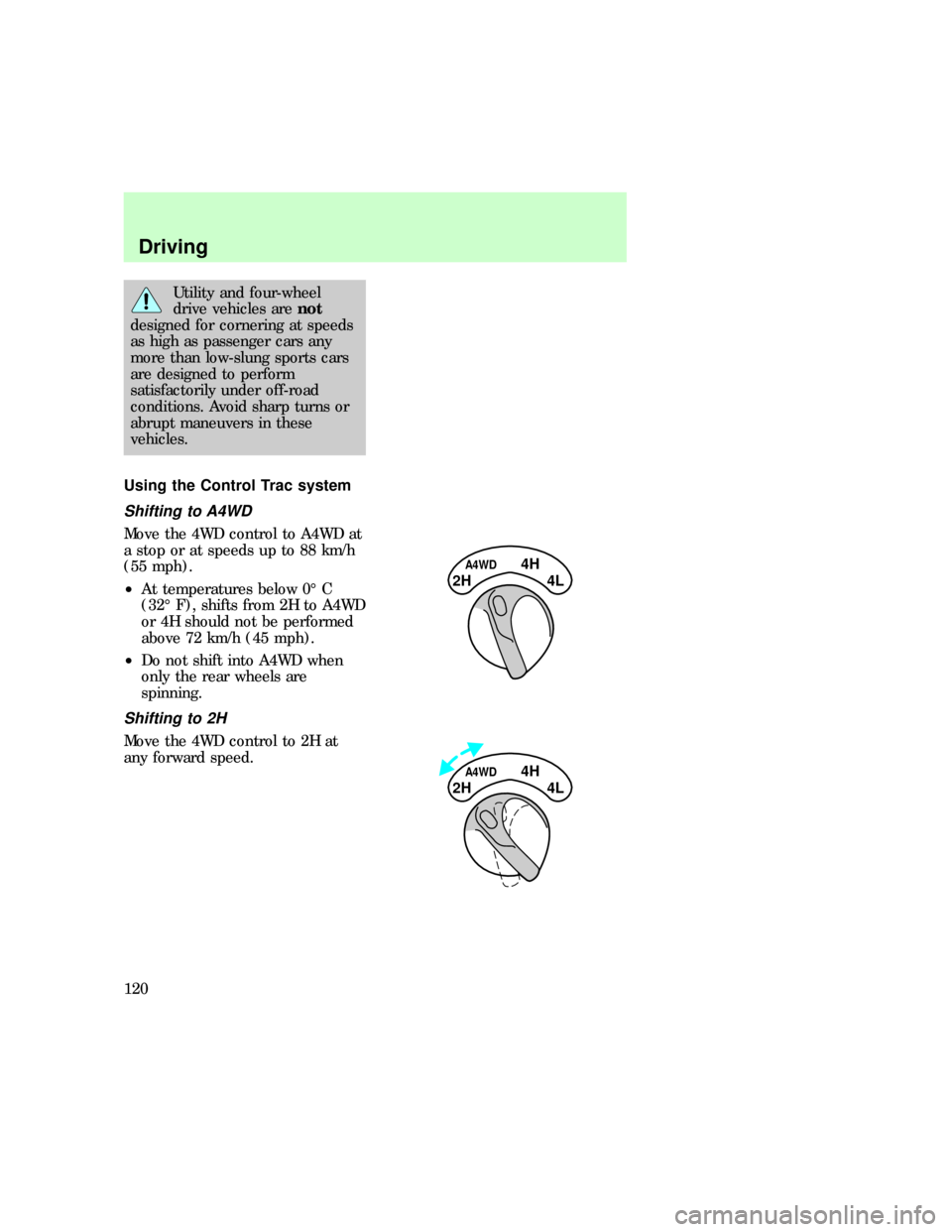
Utility and four-wheel
drive vehicles arenot
designed for cornering at speeds
as high as passenger cars any
more than low-slung sports cars
are designed to perform
satisfactorily under off-road
conditions. Avoid sharp turns or
abrupt maneuvers in these
vehicles.
Using the Control Trac system
Shifting to A4WD
Move the 4WD control to A4WD at
a stop or at speeds up to 88 km/h
(55 mph).
²At temperatures below 0É C
(32É F), shifts from 2H to A4WD
or 4H should not be performed
above 72 km/h (45 mph).
²Do not shift into A4WD when
only the rear wheels are
spinning.
Shifting to 2H
Move the 4WD control to 2H at
any forward speed.
2H 4L
A4WD4H
2H 4L
A4WD4H
exd_overall_positions
exd_2h_to_a4wd
exd_a4wd_to_2h exd_a4wd_to_4h_or_4l
Driving
120
Page 120 of 224
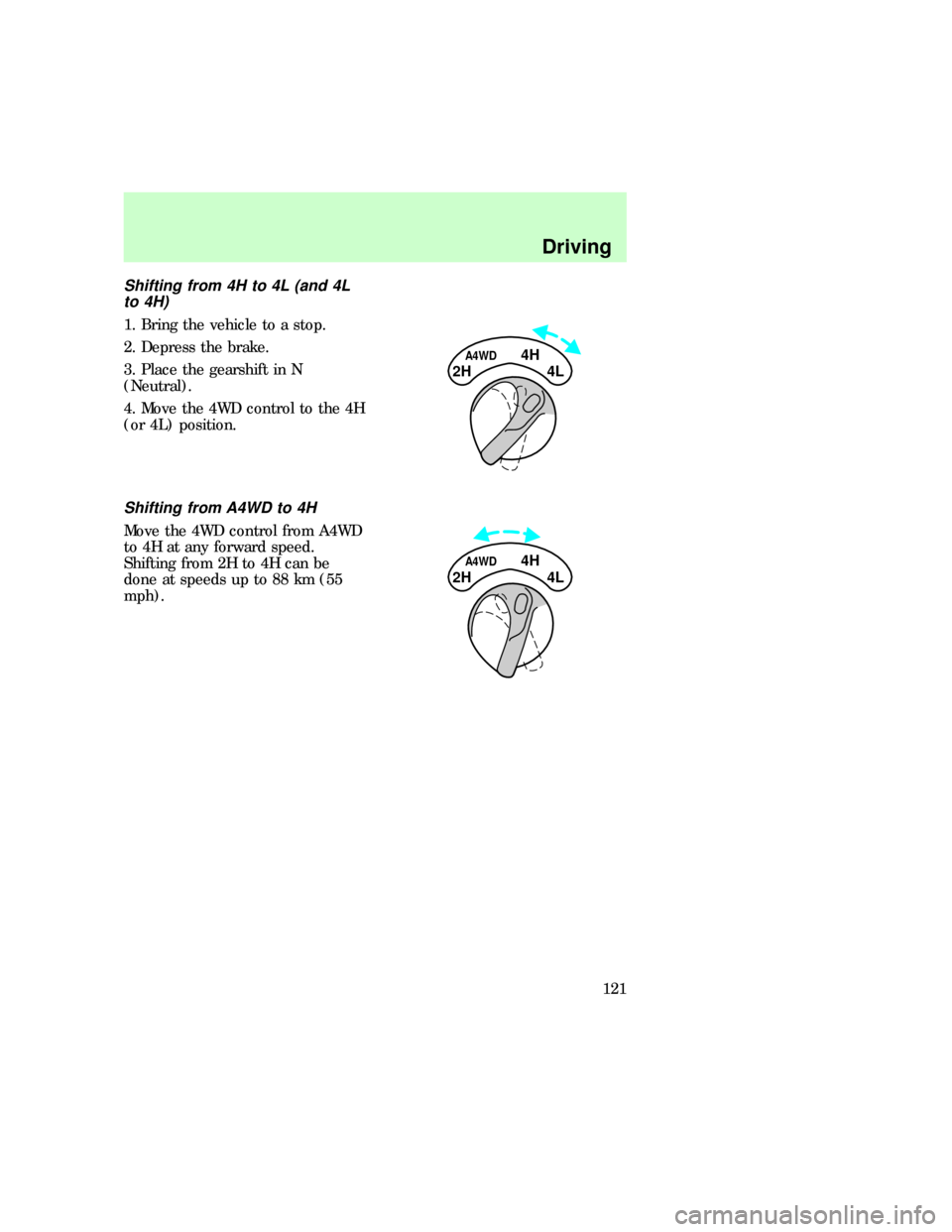
Shifting from 4H to 4L (and 4L
to 4H)
1. Bring the vehicle to a stop.
2. Depress the brake.
3. Place the gearshift in N
(Neutral).
4. Move the 4WD control to the 4H
(or 4L) position.
Shifting from A4WD to 4H
Move the 4WD control from A4WD
to 4H at any forward speed.
Shifting from 2H to 4H can be
done at speeds up to 88 km (55
mph).
2H 4L
A4WD4H
2H 4L
A4WD4H
exd_a4wd_to_4h
exd_driving_off_road
Driving
121